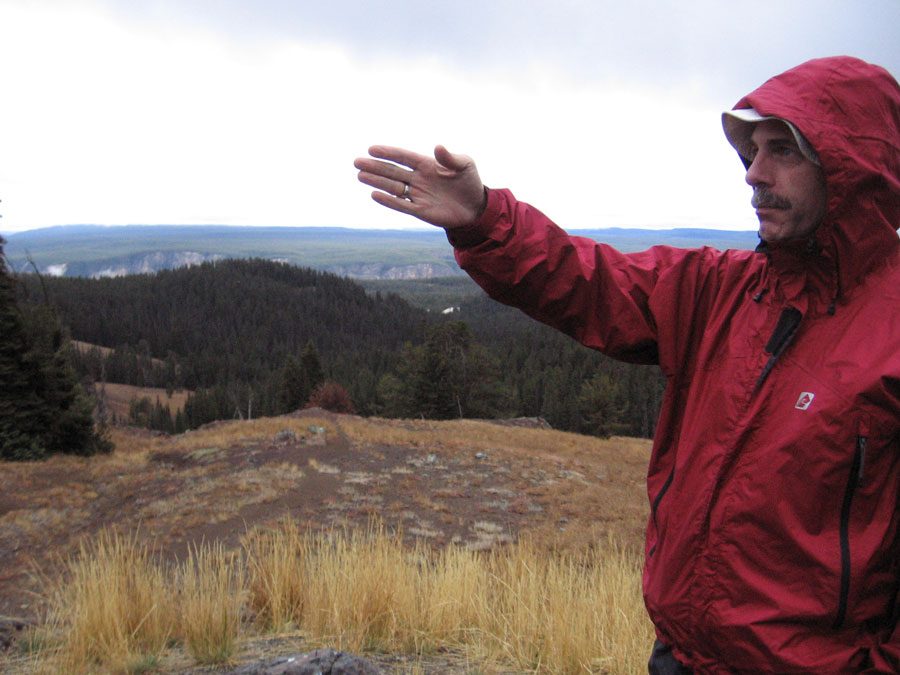Genter to return to Yellowstone with students in July
Bob Genter
This July, Environmental and Health Science Professor Robert Genter will take eight students into the majestic wilderness of Yellowstone National Park for a spring semester field course. They will study the geology, ecology, and natural history of the park, while also exploring and enjoying all the beauty the area has to offer.
Students will drive through Lamar Valley, see the Grand Canyon of Yellowstone, hike Mt. Washburn, glimpse wildlife, and witness many other incredible sights over this nine day backpacking trip.
Genter has offered this course at JSC five times, but until this spring upcoming spring semester, hasn’t been able to run it in almost a decade. Genter has been visiting Yellowstone for fifteen years and he says it is one of his favorite places.
“People often ask you what your favorite ice cream is but it’s hard to say because I like all of them. I don’t have a favorite. But Yellowstone is different. I always go back to Yellowstone.” he said.
Yellowstone is a national park located in Idaho and Montana, with the majority lying within Wyoming. The park offers amazing outdoor recreation such as hiking, camping, and fishing, and also provides incredibly beautiful opportunities to observe wildlife and geology.
“It is one place that just has everything.” Genter said. “You see geysers going off, geothermal activity, wildlife. You learn to expect something new every time.”
Yellowstone sits on top of a supervolcano, which is categorized by the United States Geological Survey as a volcano that at one point in time erupted more than 1,000 cubic kilometers of deposits. These are the volcanos that rate a number eight on the Volcano Explosivity Index, which is the largest number on the scale.
This supervolcano is responsible for creating the unbelievable geothermal activity that Yellowstone is so famous for. Features such as Old Faithful, a highly predicable geyser that spouts water up to 184ft, and the Grand Prismatic Spring, the third largest hot spring in the world known for its rainbow-like colors, are only a few of the park’s many geothermal attractions. The land inside Yellowstone is almost unimaginable, and it is no wonder that those who first visited it were inspired to protect it.
Created in 1872 by the Act of Dedication law, Yellowstone was the first national park in the US. The Act of Dedication was inspired by a comprehensive report created by the Hayden Geologial Survey of 1871 that included photographs from William Henry Jackson, and paintings from Thomas Moran.
Ferdinand V. Hayden, leader of the survey, was a strong advocate for the land and believed in “setting aside the area as a pleasure ground for the benefit and enjoyment of the people.” The report convinced US Congress to remove the land from public auction and preserve the natural wonders and beauty found there.
The area has been the subject of much painting, photography, and writing over the course of its long life. Ansel Adams, a renowned American photographer, took many photographs of the park, and famous naturalist John Muir wrote this about the area in 1898: “However orderly your excursions or aimless, again and again amid the calmest, stillest scenery you will be brought to a standstill hushed and awe-stricken before phenomena wholly new to you.”
Even Professor Genter has been included in this awe-struck tradition. The creation of the course was spurred the experience that he himself had on his first camping trip in Yellowstone. In Idaho with two of his students working on research at the Idaho Natural Laboratory, one of Genter’s friends was unable to attend a hunting trip he had been planning. The open spot was offered to Genter, who up until that point had only ever been car camping. He had never thought that carrying a heavy pack around the woods for days on end would be enjoyable. After a few nights under the stars in Yellowstone National Park, his mind was changed.
“I was hooked,” he said. “And I just thought, I’ve got to teach a course out here.” And so, he did.
Genter says the course is strenuous, but doable. In the flyer sent out to JSC students it is recommended that a person be able to jog 3 miles comfortably in order to feel confident on the trip. Activities include lots of hiking, walking with a large pack, and all food for the trip must be packed in.
“The people who join this course aren’t whiners.” Genter said. “This course seems to pick people that are adventurous and just love being far out in the woods.”
The spots for the upcoming July course are already filled, but Genter doesn’t seem to be planning to stop offering this class or visiting Yellowstone National Park anytime soon.



